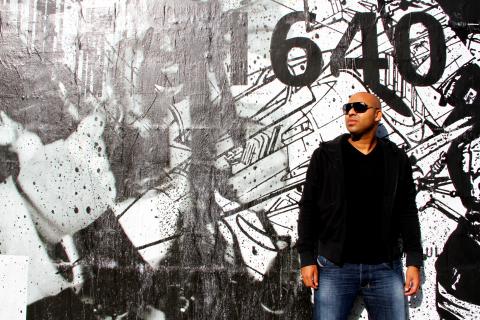Only the best DJs in the world can get people out of the house on a weeknight in Taipei. So expect a packed house this Tuesday night at Spark when Sidney Samson rolls through town. If the name doesn’t ring a bell, Riverside Motherfucker surely will.
The infectious song, whose lyrics were inspired by Tupac, was released in 2009 and went viral before catapulting to the top of music charts across the globe. There wasn’t a club, whether hip hop or dance music, that wasn’t playing it.
“It was just luck,” said Samson on garnering fame overnight. “I’m blessed with that song. It gave me the chance to show my DJ skills all over the world. I’d always dreamed about it, but never thought it would really happen,” he said.

Photo courtesy of Get In PR
But the Dutch star had already long been dominating the club scene in his native Holland. However, it was R&B and hip-hop that got him behind the decks. Samson only transitioned into a house music DJ after becoming more interested in producing.
“I’ve played guitar my whole life,” said Samson. “So I’ve also always had the desire to produce music. First it was guitar rock music and it’s developed into house music.”
“I love electro. It’s my life,” he said. “I’m always trying to find a new sound or way to produce electro house music.”
Since technology has made it easy for anyone with a knack for music and a computer to call themselves a DJ, the blogosphere has become saturated with artists trying to get noticed and the competition is fierce. But according to Samson, and many DJs like him, it all lies in the art of producing.
“Music is your main way of promoting yourself as a DJ, so I believe it’s really important for a DJ to produce music,” said Samson. The recipe worked for him anyway because it’s how Riverside was born, which led to official collaborations with Steve Aoki, Afrojack and Lil Jon.
Dubstep fans will also be delighted to hear that Sampson has been spending time getting crazy with Skrillex and Knife Party, which means Taipei can expect to hear some heavy baselines between electro riffs.
“I love to mix it up. I play from electro to hip-hop to moombathon to dubstep. Everyone needs to be ready to go crazy”
Samson is excited for his first trip to Taiwan, and is looking forward to more than the challenge of igniting a dance floor on a Tuesday night. “It’s a completely new experience for me and I’m really excited. I especially can’t wait to taste your food.”
■ Sidney Samson plays at Spark, B1, 45 Shifu Rd, Taipei City (台北市市府路45號B1) on Tuesday night. The party starts at 10:30pm and considering Hennessy is sponsoring the event, plan for a late start on Wednesday morning. Tickets are available until midnight on Monday from any iBon or FamiPort machine for NT$900 with one Hennessy drink. Admission at the door is NT$1,300 (subject to availability) with two Hennessy drinks.

In the March 9 edition of the Taipei Times a piece by Ninon Godefroy ran with the headine “The quiet, gentle rhythm of Taiwan.” It started with the line “Taiwan is a small, humble place. There is no Eiffel Tower, no pyramids — no singular attraction that draws the world’s attention.” I laughed out loud at that. This was out of no disrespect for the author or the piece, which made some interesting analogies and good points about how both Din Tai Fung’s and Taiwan Semiconductor Manufacturing Co’s (TSMC, 台積電) meticulous attention to detail and quality are not quite up to

Chinese Nationalist Party (KMT) Chairman Eric Chu (朱立倫) hatched a bold plan to charge forward and seize the initiative when he held a protest in front of the Taipei City Prosecutors’ Office. Though risky, because illegal, its success would help tackle at least six problems facing both himself and the KMT. What he did not see coming was Taipei Mayor Chiang Wan-an (將萬安) tripping him up out of the gate. In spite of Chu being the most consequential and successful KMT chairman since the early 2010s — arguably saving the party from financial ruin and restoring its electoral viability —

It is one of the more remarkable facts of Taiwan history that it was never occupied or claimed by any of the numerous kingdoms of southern China — Han or otherwise — that lay just across the water from it. None of their brilliant ministers ever discovered that Taiwan was a “core interest” of the state whose annexation was “inevitable.” As Paul Kua notes in an excellent monograph laying out how the Portuguese gave Taiwan the name “Formosa,” the first Europeans to express an interest in occupying Taiwan were the Spanish. Tonio Andrade in his seminal work, How Taiwan Became Chinese,

Toward the outside edge of Taichung City, in Wufeng District (霧峰去), sits a sprawling collection of single-story buildings with tiled roofs belonging to the Wufeng Lin (霧峰林家) family, who rose to prominence through success in military, commercial, and artistic endeavors in the 19th century. Most of these buildings have brick walls and tiled roofs in the traditional reddish-brown color, but in the middle is one incongruous property with bright white walls and a black tiled roof: Yipu Garden (頤圃). Purists may scoff at the Japanese-style exterior and its radical departure from the Fujianese architectural style of the surrounding buildings. However, the property